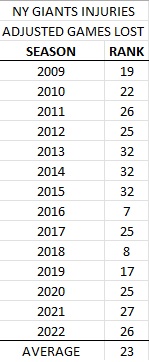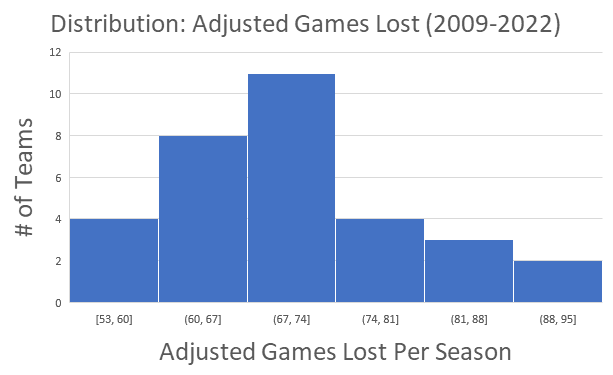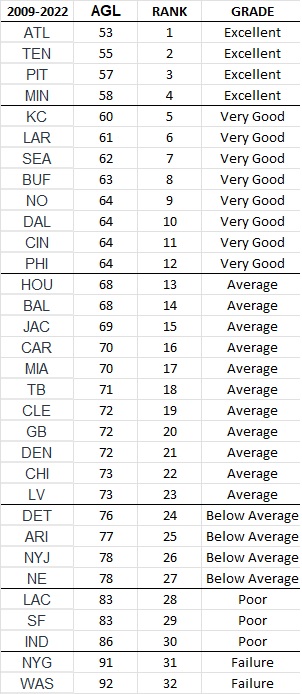We are going to break with our typical Independence Day tradition and not talk about The Rules For Winning in the NFL. If you do not know by now that it is QB, Protect QB, and Rush the QB, it means that you need to read the linked post to catch up. This year, we have an update for both long time faithful readers and new visitors of this NY Giants blog- we are going to catch up on NY Giants injuries. The results herein are eye-opening.
The website Football Outsiders does great work in chronicling many things around the NFL. Amongst their most special analysis is their reporting of Adjusted Games Lost (“AGL”). This is a measure of how many games that have been lost by each team to injury by starters:
“Adjusted games lost doesn’t just add up total injuries. It accounts for both absent players and those playing at less than 100%, and it gives more weight to injuries to expected starters and situational players than to expected backups. As such, AGL estimates the impact of injuries on teams and provides a comparable total that often succinctly explains why teams improved or declined from one year to the next.”
Aaron Schatz, Football Outsiders, 3/9/2023
The period from 2012-2021 was an ugly one for the Gmen. They underperformed on the field. In 2013, they finished in last place in the NFL as measured by AGL. We began covering the “injury bug” and saw consistent and persistent injuries well outside the norm that other teams were experiencing. Statistically, we said it was not luck, owing to past seasons defining a trend. Then in 2014, the Giants finished last in the NFL in AGL again. This was definitely not luck. It is 1 chance in 32 to finish last, all else equal. To finish in last two consecutive years was much harder to dismiss as simply luck. YET THIS IS PRECISELY WHAT THE GIANTS, and the parroting beat writers fed us. Not here. Not on this blog.
When the Giants were decimated by injuries yet again in 2015, by that point anyone claiming this was random luck was either completely ignorant or willfully ignorant. This blog’s coverage of the injury story was by far and away the best of anything out there. We still believe that beat writer lack of coverage during that period was an example of captured professionals who compromised themselves to maintain access to the team. Coughlin and staff (The Strength & Conditioning coach) were released after 2015 and the Giants briefly reverted back to the mean. We stopped covering the injuries on a regular basis because it was no longer consistently egregious. In recent years, NY Giants injuries have been anecdotally disappointing but nothing like the 2013-2015 period when it was a hospital ward.
On Monday after work I read a tweet that had a statement that seemed out of place.
In the article, they contend that Darren Waller’s past injury history will get some help from joining the Giants. The Giants? Help with injuries? Really?
(Waller) benefits from joining the Giants, who, contrary to popular belief, have one of the league’s best training and medical staffs, led by Ronnie Barnes.
Dan Benton, GiantsWire 7/3/2023
This blog happens to know a thing or two about Giants injuries, so we politely asked the writer for clarification.
We received no reply. Instead we rolled up our sleeves and did some research. We took our data from the 7 year stretch of AGL from 2009-2015, went back to Football Outsiders, and painstakingly collected all of the data for AGL from every team from every year from 2016-2022. With our data now up to date, the story was not pretty.

Over the last 14 years, the NY Giants have been consistently poor at managing player health. The Giants have had 3 Strength & Conditioning Coaches during this period: Jerry Palmieri until 2015, Aaron Wellman (2016-2019) and Craig Fitzgerald (2020-present). It is interesting to note that Ronnie Barnes’ title and oversight is not only the SVP of Medical Services, but also the Head Athletic Trainer. He oversees a staff of 26 people, including 11 MDs and 9 Trainers (including Fitzgerald).
The table above is a very large set of data. It tracks players each year on the roster for 14 years, with significant turnover taking place roughly every 2-3 years. Considering how injured players do not continue playing with new contracts, this just means that you can’t pin poor results on an injured player or two. The data set is too large. The Giants are above average in (fewer injuries in) 2 of the 14 years, and below average in the other 12 years. This “average” of 23rd ranking over the past 14 years struck me as particularly poor. So I then aggregated the AGL of the Giants and every other team over EVERY SEASON for the past 14 seasons. My sense was that if you come up in the bottom quartile regularly, it means you are likely well below that over the entire period. And the data bore that out….
The NY Giants have had an average of 91 AGLs over the past 14 seasons, which ranks them in 31st place out of 32 teams. Despite all the misery of the past decade, the one team which was worse was the Washington Redskins/Football Team/Commanders. The Giants were 13-7 against Washington from 2012-2021, when they were 61-100 overall vs the NFL. While injuries themselves are not a direct predictor of success or failure, they are a tailwind and headwind.
Here is the distribution of outcomes of all teams. We threw the results into 6 bins, i.e. there were 4 teams that average between 53-60 AGLs/year, 8 teams between 60-67, all the way to the last bin, where the Giants and Commanders reside. If you remove the last bin, you have a pretty decent looking bell-shaped distribution.

The Giants and Commanders are almost considered outliers. An outlier is a statistical anomaly, considered outside the rest of the data. Generally speaking, if a datapoint is 2.5 standard deviations outside of average, it is considered an outlier. The mean is 70.2 AGLs. The standard deviation is 9.9 AGLs, so (91.2-70.2)/9.9= 2.1 stdev. The Giants have experienced a 2.1 standard deviation greater than average incidence of injury. This is unacceptable. Remember, if this data comprised one season, we would not rush to judgment. If it comprised one coaching staff, it would probably indicate change was required. If it comprised 3 S&C staffs over a period pushing on a generation, it would be horrible. The NY Giants injury track record has to receive a failing grade. Confront the brutal facts. The numbers are what they are.
Some people might respond that the problem is not the Giants methods, but instead it is a combination of many variables, including the Met Life turf. Here, we have a beautiful control, the NY Jets. They finished at 78 AGLs, below average, but not egregiously so like the Giants. Remember, this is an average. In crude terms, EVERY YEAR, for 14 YEARS, the Jets had 13 less (91-78) adjusted games lost to injury by their players. This comparison is not meant to make the Jets look good. It is meant to rebut the idea that this is about the turf. Yes, maybe part of the reason the Giants and Jets are both below average is that their home field surface is not helping. But there is obviously something else at work here. We are happy to hear that the turf was replaced this offseason. At least John Harbaugh complained about the surface. And he played on the surface twice last season. Hopefully this is a start.
More examination of training methods needs to take place. That review has to consider the impact of the one constant over the entire period, Ronnie Barnes. When a team is in the bottom of the NFL in injuries over an extended period of time, it is hard for me to call that “one of the best training … staffs.” We have noted in the past that Barnes did not report to the GM, instead reporting directly to John Mara. Antonio Pierce, said of Barnes, he has juice. Did he have the juice to get new turf? That seemed to come from Harbaugh and others.
